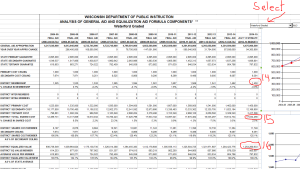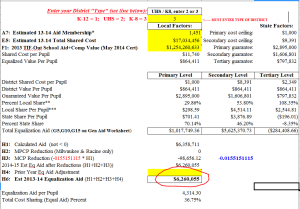 One of the logical questions our local preschool providers have had for WGSD is this: How much will we be reimbursed per student if we participate in the District’s 4K program? Unfortunately, WGSD administration has only talked in generalities, citing survey results of other districts that reimburse between $1,000 and $3,000 as a 4K stipend per 4K student.
One of the logical questions our local preschool providers have had for WGSD is this: How much will we be reimbursed per student if we participate in the District’s 4K program? Unfortunately, WGSD administration has only talked in generalities, citing survey results of other districts that reimburse between $1,000 and $3,000 as a 4K stipend per 4K student.
What we can accurately predict is how much additional state aid WGSD will get for every child that participates in their 4K program. So why the holdup in having a meaningful committee discussion about the 4K stipend? I can provide no answer, but considering the manner in which the (former) District Administrator, mishandled the financial projections for our approved 4K program we should all be concerned about his ability, or desire, to share with the WGSD Board the information they need to move forward.
To help this process along, I have explained below, in baby steps, how to determine the additional state aid the WGSD will get for every 4K student that enrolls next year (2015-16). While it is true that most of the local preschool providers have indicated they will NOT participate next year, one can only wonder if that is because they were led to believe the 4K stipend would be somewhere near the average (between $2,000 and $2,500) per student, without further justification.
Four Simple Steps to Determine the 4K Stipend

Step #1: Download and open the blank DPI worksheet titled 2014-15 Percentage Method Equalization Aid Worksheet
For the yellow box “12-B” enter the number three since we are a K-8 district.
For the yellow boxes (cells 13-B, 14-B and 15-B) see steps #2 below.

Step #2: Download and open the DPI spreadsheet titled Multi-Year Longitudinal Analysis of General and Equalization Aid Formula Components
On the top right pull down menu select “Waterford Graded”. Then, to fill in the yellow boxes on the Aid Worksheet (cells 13-B, 14-B and 15-B) use the values circled below.

Step #3: Determine the increase in State Aid for adding one 4K student.
Use the same spreadsheet from Step #1, but change cell 13-B from 1450 to 1451.
State aid to WGSD increases from $6,247,526 to $6,260,055.
The increase for every 1.0 FTE is $12,529.00
The actual increase per 4K student (at 0.6 FTE per student) is then $7,500.00
If 4K enrollment was 100 students (60 FTE) State Aid to WGSD would increase from $6,247,526 to $6,969,994, which is only $722,468.00, or about $7,225.00 per student. This is determined by changing the number in cell 13-B to 1,510.
This is less than the $7,500 per student calculated in earlier in Step #3, and the change is because for every student added WGSD is considered less “wealthy” by the DPI formula. As a result, when adding 100 students to the 4K program (60 FTE) we should only use a per student increase of $7,225.00. This is the number that will be used for Step #4.
Step #4: Determine how much to reimburse community 4K providers. A few suggestions are offered below.
| Option | Community 4K | Admin/Bussing | Tax Relief/Other | Total |
|---|---|---|---|---|
| 1 | $3,500 | $725 | $3,000 | $7,225 |
| 2 | $3,250 | $725 | $3,250 | $7,225 |
| 3 | $3,000 | $725 | $3,500 | $7,225 |
Question: How can offering a “community model” with a fair per student stipend benefit WGSD taxpayers?
Answer: The more choices there are for families the more students that will enroll.
Some parents will simply prefer the smaller setting, same sight wrap around care, and teachers they already know for their child’s 4K experience. The fewer choices parents have the more likely they will be to keep them at home or pay for their own preschool.
| Involvement | Enrollment x Tax Relief/Other | Total Tax Relief/Other |
|---|---|---|
| Option #1 with 100 students | 100 x $3,000 | $300,000 |
| Option #2 with 90 students | 90 x $3,250 | $290,000 |
| Option #3 with 80 students | 80 x $3,500 | $280,000 |
As you can see from the table above, it may be better to offer the community providers a larger per student stipend in order to make sure their participation is feasible. Option #1, which offers the community provider $500 more per student, could create more total surplus dollars that can be used as tax relief, or to help fund other district initiatives and programs. The question should not be, “How little can we pay the community providers”, but rather, “How can we get maximum student participation?”.

